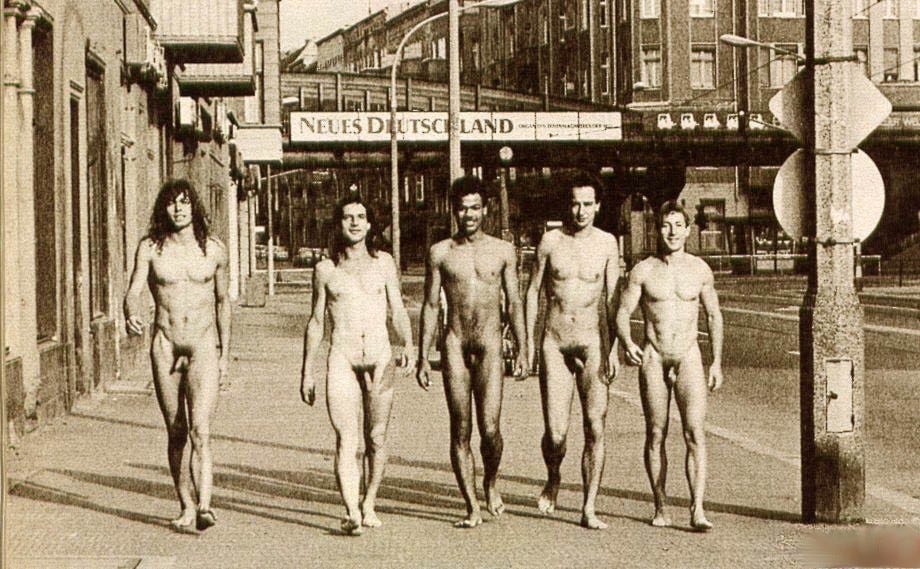‘FKK in der DDR’: East Germany’s socialist nudism
Description
Editor’s note: This story was first published one year ago today. We’re posting it again today because, well, it’s a fascinating and compelling sample of journalistic research by writer , and if you haven’t already read it, it’s still very much worth your attention. We hope you enjoy.
Thousands of red banners and German tri-color flags fluttered in the warm breeze on July 4, 1987 as columns of people snaked their way through the streets of Berlin. Citizen participants proudly showed off the latest economic achievements of the factories and farms where they worked. Actors and dancers performed elaborate spectacles. Soldiers from the National People’s Army demonstrated their determination to defend the country from capitalist incursion.
It was a scene not so different from the many parades and processions held in the Eastern Bloc countries during the Cold War years. The occasion this time was the 750th birthday of Berlin, capital of the “workers’ and peasants’ state”—the German Democratic Republic, or East Germany, as many knew it.
This particular parade featured one group of revelers, however, that set it apart from not only the staid, gray image of communism that Western propaganda tried to paint but also distinguished it from all other state-sponsored events held anywhere on Earth in modern times.
Going right down the center of Karl-Marx-Allee was a float totally unlike the others belonging to various sporting clubs and recreational groups. Atop it, surrounded by fishing poles, nets, and other tackle, sat a couple of beaming bare-breasted women in lawn chairs. The cameras didn’t shy away, nor did Erich Honecker, leader of the GDR. Viewers watched on their televisions at home as the Chairman of the State Council waved and smiled at the sunbathers.
A few weeks later, a river parade was staged in the suburbs as part of the same anniversary festivities. There, a boat carrying dozens of naked men and women and a sign reading “FKK-Anhänger aus Rahnsdorf,” “Nudists of Rahnsdorf,” motored past the East German officialdom, once more earning cheers.
Such scenes may seem unthinkable, given the prudishness and restrictive instincts of most governments, but East Germans weren’t the least bit shocked by their politicians’ reactions. That’s because they’d grown up in a society where nudity was normalized and body shame was officially discouraged.
Survey data collected in 1990, just months before the GDR disappeared, showed that 68% of apprentices between the ages of 16 and 18 had swum in the nude; for young workers in their 20s and 30s, it was 81%; and among students, the number hit 87%.1 Baden ohne, or “bathing without” in German, was a pastime that had grown in popularity with each new generation in the GDR.
Germany is, of course, widely known as the birthplace of modern nudism, of freikörperkultur (free body culture, or FKK). It’s a tradition that has carried through from its roots in the late 19th century lebesnreform (life-reform) movements on up to the present day. But it was in the GDR that FKK, in many ways, reached its pinnacle. East Germany no longer exists, but the persistence of German naturism owes a lot to the fact that it did.

Though initially suppressed after the GDR’s founding in 1949, by the 1970s and ’80s, grassroots nude culture gained official endorsement as a socialist antidote to the commercialized sexuality of capitalism. It became a supplement to the state’s Marxist ideology. As an exhibit in the DDR Museum in Berlin today states, for many East German communists, “nakedness was an expression of classlessness.”2
Years after the reunification of Germany, public nudity remains a faultline between the country’s two halves. It is a fading hallmark of “ostalgie,” the “East nostalgia” embraced by those who miss life under socialism.3 While the society that existed on the eastern side of the Berlin Wall was undeniably authoritarian in many respects, the “people’s nudism” that flourished there contained a liberatory potential that is still worthy of study today.
Proletarian nudism before the war
From its start, nudism in the GDR was a populist affair, a trend that the people themselves developed and forced the state to recognize. Rising from the ruins of World War II, the government established in the Soviet Occupation Zone was eager to make a fresh start, to show it was unbound by Germany’s imperialist and fascist pasts. There was one old tradition, however, which proved difficult to extinguish, especially because its historical lineage was intertwined with the socialist ideology embraced by the new state.
Freikörperkultur, the original modern nudist movement, had eclectic origins, with links to healthier living fads, middle class reformism, vegetarianism, conservationism, critiques of industrialization and urbanism, as well as eugenics and right-wing nationalism.4 It also possessed a strong socialist and egalitarian element, however, whose adherents actually constituted the majority of German nudists in the 1920s.5






